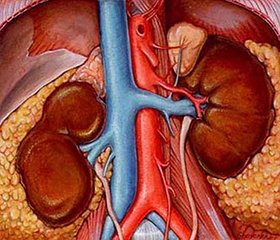Журнал «Здоровье ребенка» 2 (61) 2015
Вернуться к номеру
Epiphyseal hormone melatonin and chronic kidney disease (review of literature and our own research)
Авторы: Kaladze NN, Slobodian EI, Govdalyuk AL — Crimea State Medical University named after S.I.Georgievskogo, Simferopol
Рубрики: Педиатрия/Неонатология
Разделы: Клинические исследования
Версия для печати
In the last decade it has been proven that the reduction of melatonin secretion at night time can be linked to a number of pathologies of the human body. Melatonin - the main hormone of the pineal gland performing molecular neuro-endocrine-immune signal coordination of biological processes in living organisms. The main physiological functions of melatonin are biorythmological, thermoregulatory, antioxidant, immunomodulatory, anti-stress effects and regulation of puberty. It mediates pluripotent protection of organs and tissues, has anti-inflammatory, antihypertensive, antiapoptotic and anti-reconstruction action. The daily periodicity of symptoms such as sleep disturbances, nocturia, severe pastosity in the morning, frequent urination in the morning are observed in patients with chronic kidney disease (CKD). Greater frequency of exacerbations in the autumn-spring period suggests seasonal periodicity. Both suggesting the involvement of functional changes in the activity of the pineal gland in the formation and progression of symptoms of CKD. The structure of biorhythms of renal function reflects the stages of development of the pathological process in the kidneys. The stronger pathological process, the more pronounced circadian rhythm violations. Melatonin is a universal endogenous adaptogen. It regulates homeostasis in accordance with changes in the environment and exposure of pathogenic factors on the body. Numerous experimental and clinical studies presented in this article have been proven undeniable influence of the pineal gland and its hormone melatonin on renal functional features. My own study had 112 children with CKD stage I-II. The sickness progressed during chronic obstructive pyelonephritis (CP). The children were aged 6 to 16. The were more females than males. The clinical history and laboratory data confirmed the state of clinical and laboratory remission in all patients. The diagnosis is based on common criteria in accordance with the ICD-10 coding. The control group consisted of 15 healthy children of the same age and gender. The complex laboratory investigations included the traditionally accepted in the nephro-urological practice examination. In addition the production of melatonin was determined by excretion of its main metabolite 6-sulfatoxymelatonin (aMT6s). It was collected at night (6:00 AM) and day (6:00 PM) urine samples. The results showed a disruption in circadian rhythm and quantative production of melatonin. The lowest concentration of melatonin occurs at approximately 4 o'clock in the day , the highest at 2-4 o'clock in the morning. The 80-90% of melatonin is excreted in the urine as metabolite aMT6s. Therefore, it's maximum and minimum concentration can be measured 2-4 hours later in urine. In order to determine the peak of maximum and minimum concentrations of urinary aMT6s, the urine collection was performed at 6 o’clock at the morning (6:00 AM) and 6 o’clock at night (6:00 PM). The selected time was completely comfortable for the patients. It does not violate their schedule for sleep and wakefulness. Studies have shown that in patients with CP the changes of excretion of aMT6s are heterogeneous. In children with CP in the stage rack clinical and laboratory remission (68.3%), the peak levels of urinary aMT6s matched the intact correct rhythm of melatonin secretion. They did not differ from those of healthy children. With increasing the duration of bacterio-inflammatory renal disease, frequency of exacerbations, reduction of functional parameters we observed a decrease in nocturnal peak of the aMT6s and increase in daily peak. This is an indicator of increasing the production of melatonin by extrapineal sources - a compensatory reaction due to the suppression of melatonin production by the pineal gland. There was an inverse correlation relationship of urinary aMT6s with IL-17 and the main profibrotic cytokine TGF- β1. TGF- β1 has numerous inflammatory and hematopoietic effects on epithelial, endothelial cells, fibroblasts. It has pathogenetic relation to the development of chronic inflammatory diseases. It has, on the contrary, a positive correlation with a anti-inflammatory cytokine IL-4. In this study, the peak concentration of urinary aMT6s had significant differences in patients with first and second stages of CKD. These differences were observed during the day and at night (p <0.001). The value of glomerular filtration rate (GFR) was determined by Schwartz formula. It was found the direct dependence of GFR and night values of urinary aMT6s. Most noticeable changes in melatonin production were demonstrated in patients with clinical manifestation of desynchronization process of urine formation - nocturia. Almost all of the children in this group were characterized by fatigue in school, physical and psycho-emotional exhaustion, drowsiness. Most of the children had a nap, regardless of age. Syndrome of chronic intoxication has a negative impact on the regulation of the sleep-wake rhythm and leads to a pronounced inversion rhythm of melatonin secretion. Also it aggravates the clinical manifestations of CP. Thus, these studies clearly reveal a violation of the quantitative production and circadian rhythm of melatonin secretion in patients with CKD. Children are no exception. Perhaps these changes can be regarded as one of the modifiable risk factors of debut and progression of CKD and certainly needs further study and discussion.

